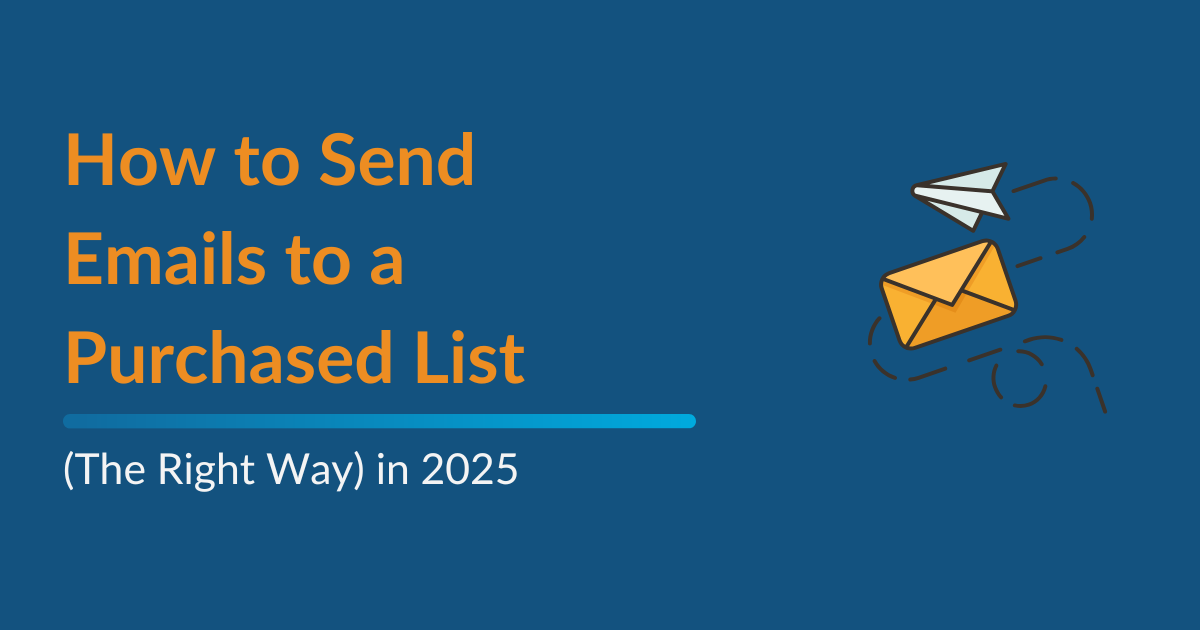
Updated on July 29, 2025
If you’ve ever bought a list of contacts and tried using Mailchimp or Constant Contact to send emails, you probably ran into a wall. Most mainstream email platforms don’t allow purchased lists—full stop.
So what do you do if you have a third-party list and need to run a cold email campaign legally and effectively?
In 2025, the answer isn’t to give up—it’s to use the right strategy, infrastructure, and tools built for this exact use case. Here’s how to do it the right way without landing in spam folders or violating the law.
Can You Legally Email a Purchased List?
Yes—if you’re in the U.S. and follow the rules under the CAN-SPAM Act.
Here’s what the law requires:
-
You must include a valid unsubscribe link
-
You must identify the sender and include a physical address
-
You must honor opt-outs promptly
-
You cannot use deceptive subject lines or header information
The CAN-SPAM Act is permission-agnostic. That means you don’t have to get prior opt-in to send an email—unlike GDPR in the EU or CASL in Canada. But just because it’s legal doesn’t mean it’s effective unless you set things up correctly.
Why Most Email Platforms Ban Purchased Lists
Platforms like Mailchimp, HubSpot, and Constant Contact operate on a shared IP model. If one user spams, the entire platform's reputation suffers. That’s why they strictly require opt-in lists—and ban purchased contacts outright.
Trying to sneak purchased lists into those platforms is a fast way to get flagged, suspended, or banned. So if you’re serious about cold email at scale, you need a platform built for it.
The Real Risk: Poor Deliverability
Sending cold emails from the wrong setup can hurt your domain’s reputation fast. Purchased lists often include:
-
Stale or invalid emails
-
Spam traps
-
Recipients who aren’t expecting your message
The result? Low open rates, high bounce rates, and more emails landing in spam.
The fix isn’t just to clean the list—it’s to run cold outreach through a dedicated infrastructure that protects your primary domain and uses smart deliverability techniques.
How to Safely Email a Purchased List (Step-by-Step)
1. Use a Platform Built for Purchased Lists
Don’t use Mailchimp. Don’t use Klaviyo. Don’t use anything that requires explicit consent.
Instead, use a platform like MailClickConvert, designed specifically for purchased or cold email lists. It gives you:
-
Dedicated sending domains and IPs
-
Built-in list cleaning and email validation
-
CAN-SPAM compliance features
-
Deliverability-focused infrastructure
You need a system that isolates your cold outreach from your core brand domain—MailClickConvert does exactly that.
2. Validate Your List First
Never send to raw data straight from a vendor. Before uploading your list:
-
Run it through an email verification tool
-
Remove invalid addresses, duplicates, and role-based emails (like info@, support@)
-
Suppress any known hard bounces or spam traps
MailClickConvert handles validation during upload, but running it through a tool like ZeroBounce or NeverBounce beforehand adds another layer of protection.
3. Use Segmentation and Personalization
Even if the list is cold, don’t treat everyone the same. Segment by industry, job title, or use case. Then use merge tags to personalize:
-
First name
-
Company
-
Relevant pain point or offer
Cold email still works in 2025—but mass-blasting generic templates doesn’t. Relevance drives replies.
4. Keep It Short and Compliant
Cold emails should look like a one-to-one message, not a fancy newsletter.
Stick to plain text with a clear value proposition. Include:
-
Who you are
-
Why you're reaching out
-
What they can do next (CTA)
-
A clear unsubscribe link (MailClickConvert inserts this automatically)
Avoid over-designing. Simple, clear, and human wins.
5. Start With a Ramp-Up Period
If you’re sending to a large list, don’t go full blast on day one.
Start with a small batch to test deliverability and engagement. Monitor:
-
Bounce rate
-
Open rate
-
Spam complaints
Gradually increase volume. If you're using MailClickConvert, you can schedule and throttle sending across multiple IPs to avoid spikes that trigger filters.
6. Track and Iterate
Use campaign reports to identify what’s working. Track:
-
Open and click rates
-
Domain-level engagement (which ISPs are filtering you?)
-
Reply and conversion rates
Test subject lines, email copy, and timing. Iterate based on results. Cold email isn’t set-and-forget—it’s ongoing optimization.
Why MailClickConvert Is Built for Purchased Lists
MailClickConvert was designed from the ground up for bulk cold email campaigns using third-party or purchased lists. It solves every issue that gets marketers flagged on other platforms.
✅ Sends from dedicated infrastructure (not your brand domain)
✅ Cleans your list during upload
✅ Helps you stay 100% CAN-SPAM compliant
✅ Includes autoresponders, analytics, and A/B testing
✅ Scales easily to millions of emails monthly
Whether you're emailing 10,000 or 1 million contacts, MailClickConvert keeps your campaigns safe and effective.
Final Thoughts
In 2025, cold email is still one of the fastest ways to generate B2B leads—if you do it right.
Don’t cut corners. Don’t send through tools that weren’t built for this. And don’t ruin your domain over a cheap list.
If you’re serious about emailing purchased lists the right way, start with the right platform and process.
👉 Get started with MailClickConvert and launch smarter cold campaigns today.

